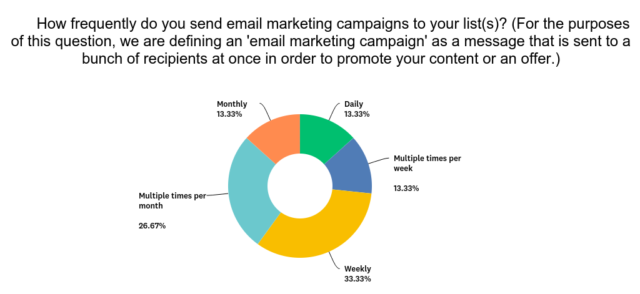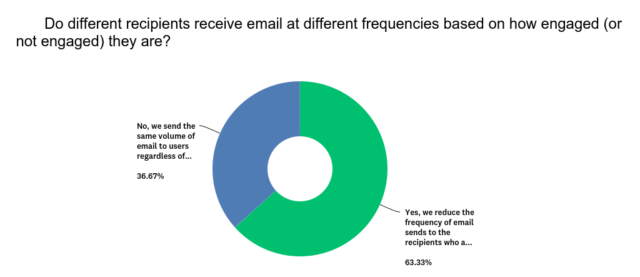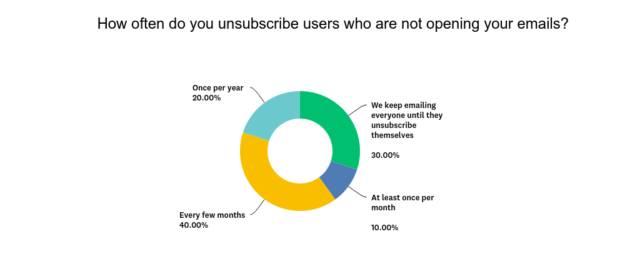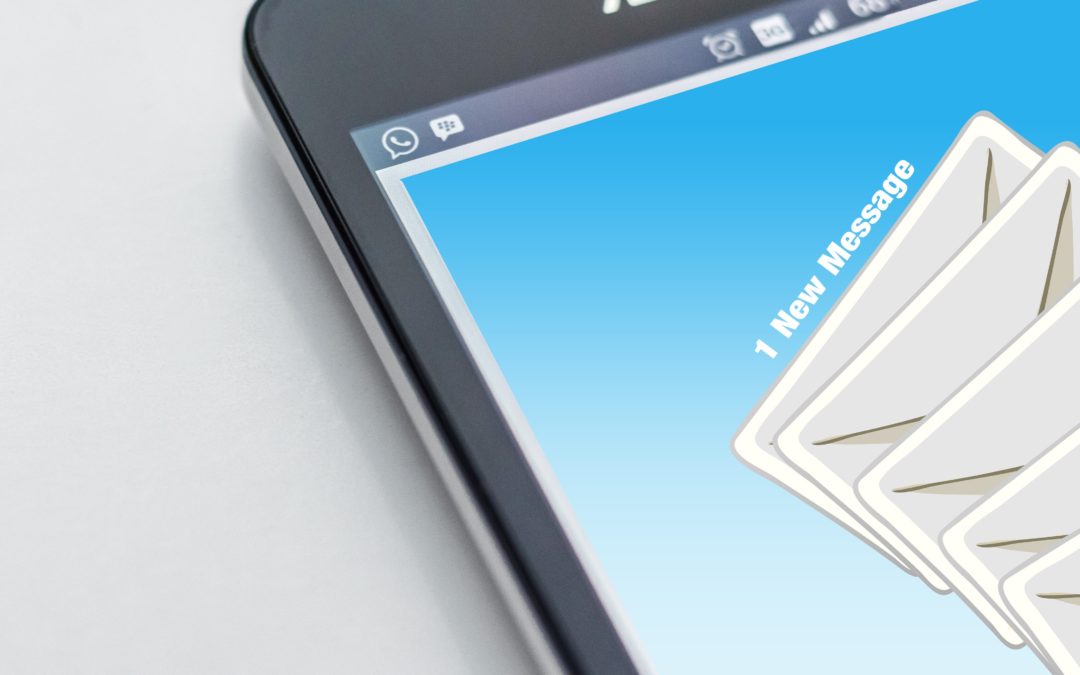How often are you sending emails that your subscribers technically opted into, but don’t actually want?
That’s a really hard question to answer and highlights a problem many email marketers might not realize they have called graymail.
Graymail, as mentioned above, are emails your subscribers may have opted into but don’t actually want. For example, they may have signed up for a webinar, but don’t necessarily want the marketing emails that follow.
It’s a bigger problem than marketers think, and while it results in bigger lists, it doesn’t necessarily translate to higher email engagement, regardless of how often you’re sending email.
HubSpot even discontinued its instant blog notifications after new blog posts were published, as they were sometimes sending up to four emails a day, resulting in unsubscribes and low engagement.
So we got to thinking about how other marketers and the companies they work for tackling these issues.
How often should you send marketing emails?
We partnered with Seventh Sense to ask real-world marketers about how they determine email frequency and measure its impact on engagement.
The people of Seventh Sense take send time frequency more seriously than most. They’ve built a tool that not only sends email to every subscriber at his or her optimal time but also uses automatic engagement based segmentation to email customers at their preferred frequency, too.
To go deep into how other marketers optimize their send time, we first needed to level set to see how often marketers are sending email to their subscribers today.

Weekly and “multiple times per month” were the most common answers.
But many marketers send emails more than once a week, as well. And quite a few send less.
As you’ll see, it depends on the business and the audience.
Most businesses also adjust their send frequency based on how engaged recipients are:

Though we were surprised to find that 37% of marketers continue sending the same volume of email even when recipients aren’t very engaged.
The fact that 30% of marketers email people until they unsubscribe was surprising, and to our point earlier, leads to the issue of graymail.

If you’re looking to nail your email send frequency, looking at recipient engagement (and other metrics) is crucial. Here’s how our respondents said you should go about getting the right frequency and increasing engagement with your marketing campaigns.
Editor’s note: Want to see if your email marketing efforts actually drive quality website visits? Check out this free template and see which campaigns drive the most visits, the days that see more traffic, the devices your subscribers are using, and more.

Start with Weekly Emails
Among marketers that responded to our survey, the most common sending frequency was weekly.
“We’ve been testing our email send frequency for years, both for ourselves and our clients, and sending weekly emails in most cases has driven the highest return on investment,” says Palmer Ad Agency‘s director of marketing, Adam Wiggins.
He also noted that weekly isn’t the best answer for everyone. Instead, companies should focus on providing value with their emails (which we’ll talk about in more detail).
Other marketers emphasized specific reasons they have for emailing weekly. Derrick Lawless, marketing director at D. Lawless Hardware, says that “[w]eekly is a good timeframe for our business because it allows us to rotate sales and promotions,” which keeps people coming back to the online store regularly.
“At the same time, a week is long enough to collect content, formulate ideas, and organize the stuff that has to be done in the background such as creating coupons and creating graphics,” Lawless added.
Lawless also noted that there’s no way to get your email frequency right on your first try. You’ll need to experiment with send frequency, content, and other factors to see what works with your particular customer base.
You can use an email marketing platform to get useful data like that, says Arya Bina, founder of Kobe Digital. “By gathering the reports MailChimp provides, we see that Monday mornings have a higher open rate compared to other days or times of the week.”
Bina determined that emailing her list weekly lowered unsubscribe rates.
Markelle Harden, founder of Classy Inbound, sums up the data that she’s seen: “In the B2B space, sending emails more than one time per week drives up the unsubscribe rate. In the B2C space, sending emails more than one time per week causes the open rate to decline,” she says.
“The data shows that once per week is the ‘sweet spot’ for sending emails across industries and platforms.”
So if you’re going to experiment with different frequencies, starting with weekly is a good way to go.
A Few Times a Month Works Well for B2B
Not everyone has found success with weekly emails, though. Sometimes a more hands-off approach works.
Regpack marketing director Samantha Avneri found that her company’s emails didn’t have enough “meat” when they were sent weekly. “We stick to a general format which is sharing a recent blog post or client spotlight post, along with a recent client review.”
This content is a specific mix with a goal: “to show the value and knowledge we offer, backed up by a client review to further this point that we offer a great product and know what we’re talking about in our space.”
Interestingly, several of our respondents mentioned that this frequency is good for B2B companies.
Cloud Employee sends newsletters “every second and fourth week of the month,” says marketing manager January Collamat. “We find that this frequency works best for our audience (B2B). Any more than that we’d get lower open rates & click rates, and a higher number of unsubscribes.”
Pierre de Braux, content strategist at Spiralytics, told us that they use a two-week interval. It works “because, as a marketing agency, our lead time for converting new customers can take a while (sometimes 6 months to a year),” he says.
“We’d like our content funnel to last at least that long, and sending nurturing emails any more frequently would mean increasing the chances of causing engagement fatigue.”
It’s important to keep your goal in mind, says SizzleForce founder Stephanie Nivinskus. “[W]hen our goal is simply to stay in front of an audience so they think of us when they’re ready to make a purchasing decision, we send emails 2–4x/month.”
Twice monthly also keeps Jumpstart Go‘s recipients looking forward to the emails, says David Denning, head of business development. “We give them time to digest each one before sending another.”
Helen from SE Ranking also alludes to a point that we’ll discuss in a moment. Her company sends platform updates once per month and curated articles once every two months. So recipients see one or two emails per month. But it’s not always the same type of content.
Multiple Times Per Week Builds a Relationship
Sending more than once a week might seem like overkill to many marketers out there, but we got some great points in favor of it.
JP Wallhorn, founder of Syntx, points out that people get a lot of emails, and it’s easy for them to miss something you send. Especially if you just interacted with that customer, it’s crucial to get back in touch. Sending multiple emails per week will help you do that.
“People are more likely to buy from you if they know you, like you, and trust you,” says Amanda Abella, founder of Make Money Your Honey. “If someone has opted in to get emails from you, they are already primed to purchase.”
To facilitate that priming, Abella sends out daily emails. “I’ve basically trained them to expect to hear from me which makes sales easier.” Since starting daily emails, her sales have increased by 40%.
OnPoint Internet Marketing‘s digital marketing specialist Craig de Borba also brought up the sales cycle: “[Y]ou need to email your list a minimum of once per week to keep engagement up. Current customers can be emailed less, but those that haven’t ever bought need to be mailed more often.”
The value that you provide may determine when you send your emails, too. Jay Perkins, co-founder of Kettlebell Kings, sends emails to his list twice a week.
“We send email at this frequency because the main way people get in our equipment sales pipeline is by signing up for free kettlebell workouts. They expect to get a new workout in their inbox each week and this is a great way to provide value and stay in prospects’ minds.”
Carney‘s marketing director Mark Rogers thinks about it a different way: “If our subscribers are getting value from our newsletter, they’ll respect us for it. Respect eventually leads to new clients.”
Which is why Carney sends daily emails “like theSkimm, but for marketers.” It shows their expertise and engages clients. And it works; with a list of around 12,000 people, Carney gets open rates of 30% and CTRs of 4%.
Monthly Emails Prevent Inbox Overload
While there were fewer respondents that encouraged monthly email sending, we did have some that found success with it. Pacific54 founder Avi Cohen says that monthly emails allow his agency “to be present in the inbox of our subscribers, but not to overload them to a point of clicking unsubscribe.”
Recipients don’t just get marketing emails, though. In addition to the monthly newsletter, they also get welcome emails and anniversary reminders for a personal touch.
Segment Users for Multiple Schedules
Some marketers didn’t recommend a single frequency. Instead, they suggested segmenting your email list and sending at different frequencies to different segments.
For example, Accelity Marketing sends “monthly campaigns that are 2–4 emails in a month—but we’re not hitting up the same audience each time,” says marketing manager Jenny Weeden. “This allows us to warm up multiple personas without overwhelming them, and keeps our messaging targeted.”
Maria from Big Sea gave us some examples from her experience in sending marketing emails to over 90,000 law school prospects. Emails are sent an average of every ten days, but “few messages are appropriate for the entire list, and those are reserved for major tips (like LSAT study help) or important deadlines.”
Other emails, like those focusing on “campus groups, externships, or programs for military veterans, are sent to segmented lists to make sure messaging aligns to expectations and needs.”
After receiving a list of new contacts, Inside Sales Solutions “segments the contacts based on their interest, position, and pain point,” says Dani Stancheva, digital marketing manager. “We do this because we find the very generic, HTML-type, mass emails to be incredibly ineffective and takes away from our boutique-persona that we try to embody.”
Stancheva also notes that they start with a three-emails-in-three-days nurturing cycle before getting recipients into the standard email flow.
Always Add Value to Reduce Unsubscribes
If you’ve read our guide to getting more click-throughs on your emails, you know that marketers are really big on providing value.
And in our discussion of email frequency, we heard even more about it. In short, some people told us that the frequency matters less than the value you provide.
In fact, you should think about that before you even consider frequency, says Metric Digital‘s head of email Cory Smith.
“What will you send your users? Every email you send should provide some value to your customers.”
(He also cautioned that increased frequency often results in decreased conversion, negating potential benefits. So keep that in mind when you’re monitoring your metrics.)
Understand Your Customers
When thinking about the value you provide your customers, it’s crucial to focus on what works for your business and the type of customers you’re working with.
Lacey Woltz, digital marketing specialist at Blue Compass, broke it down for us.
- Daily emails may work if you can create enough content (she gave the example of a lifestyle and wellness coach sending out positive affirmations, recipe suggestions, and workout tips).
- Weekly or multiple weekly emails are more common among sites like e-commerce businesses where you can maintain a relationship without hitting the junk folder.
- More sporadic emails fit companies and products that are used less often (Woltz mentioned a roofing contractor and other businesses with longer sales cycles).
Of course, the key is to experiment and watch your metrics, she says.
In the end, Maria from Big Sea sums it up best: “Everyone on the marketing team is committed to sending emails we wouldn’t mind getting—or even forwarding. That helps serve as a litmus test in terms of ‘are we being spammy or is this helpful?”
Follow Your Metrics
If there was one thing that everyone agreed on, it was that your metrics should guide you. Every business and audience is different.
For example, Hotels.ng‘s campaigns get the best engagement on Monday, Wednesday, Thursday, and Friday. And their best times are 9:00–11:00 AM and 5:00–8:00PM, says intern Chinedu Okigbo.
These hours, he says, work well because most people are transitioning between their working and personal lives. By looking at open rates, spam percentages, clickthroughs, bounce rates, and unsubscribes, Hotels.ng has optimized not only their send frequency but the time as well.
And if your metrics show you other patterns, you can work with those, too.
Imagine Business Development uses a variety of variables to determine to send frequency. “These include where they are in our engagement management lifecycle, ideal client segmentation, the action we’re solving for and data on their engagement patterns,” says founder Doug Davidoff.
“If they demonstrate a declining engagement pattern we use the artificial intelligence capabilities of Seventh Sense to slow down the frequency and if the engagement pattern drops below a certain level we change the type of email that is sent.”
This flexible method of email might sound complicated, but marketing automation software gives you the power to customize send schedules. It’s likely this method will become more common.
In the end, it’s all about your customers. Don’t lose sight of them, and you’ll find the perfect send frequency for your marketing campaigns.
(Editor’s note: If you are already using SeventhSense, you can see how your customers are interacting with your emails by using one of our templates to combine data from Seventh Sense and Google Analytics or Seventh Sense and HubSpot. You’ll have all the data you need to optimize send frequency for your specific audience.)
How often do you send marketing emails? How did you decide on that frequency? Leave a comment below to let us know.

